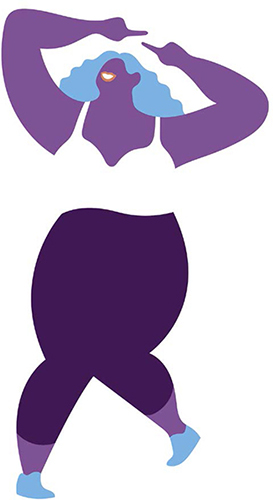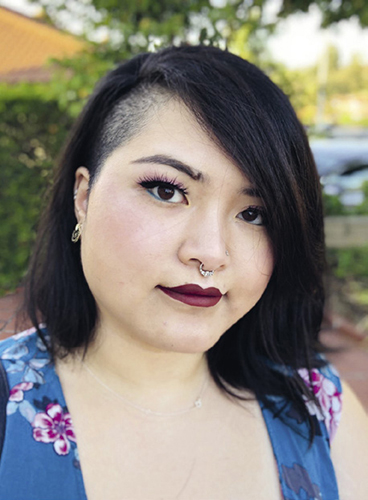Fat, And

0
Take the constant: fat.
What does it mean to be fat? Being fat just means you have one of a range of body types carrying some amount of adipose tissue above an arbitrarily determined average point.
That’s it. Being fat doesn’t have anything to do with character, health, personality, attractiveness, or worth.
And yet.
1
I’m sure others in this collection will cover the myriad obstacles we face as fat people: the daily struggles, like putting together an inspired outfit from the limited fashion offerings we’re afforded. The endless confrontations—whether in doctors’ offices or on the street—that divorce our bodies from our humanity. The frustration of never seeing ourselves in fiction or, if we do, seeing ourselves only as the butt of some joke.
So I’ll let others tackle that for now.
I want to talk about something else: the way we as people are layered, and never as just one static identity. We cannot be summed up in one term. To examine our multilayered selves, we’ve got to start with the constant—fat—and set aside the rest.
2
Who is “fat”? When we talk about what it means to be fat, what range of body types are we considering? And above what average point of adipose tissue? But being fat is never really about these abstract numbers or details—which can and often do change according to age, era, geography, and where you are in your life journey. To illustrate my point, I want to tell my own story.
I don’t think it’d be possible to understand my upbringing without understanding the demographics of the area where I grew up. I’m first-generation Chinese American, born in California to two people who emigrated in the eighties from China to the United States to pursue higher education. I grew up in the San Gabriel Valley of Southern California, in a suburb that’s half Asian American. By the time I was in high school, most of my classes were predominantly comprised of Asian Americans with a sprinkling of other Indigenous, Black, and/or people of color, and the occasional token white person.
Aside from the demographics and some cultural quirks, my formative years were representative of a fairly typical US upbringing: silly things kids get up to, inexplicable drama, mismatches between parental expectations and kids’ agency . . . and, of course, fussing about image.
From a young age—middle school or earlier—both my mother and I berated my thighs for being too large in shorts, my muffin top for spilling over my jeans, my dresses for failing to flatter. I was fortunate enough to travel to China several times growing up. I began to expect that—if I normally wore a medium in the United States—I would be lucky to squeeze into an extra large in China. Most of my friends at the time were other Asian Americans (usually other East Asians), as that was the dominant demographic in my California suburb. It became harder for me to shop with them as my body expanded.
I developed a conscious awareness that I was fat . . . for an Asian person. Even years later as I write this essay, I find the idea nagging me. I’m not fat; I’m only fat . . . for an Asian person.
What does that even mean?
3
Fat . . . for an Asian person.
The for carries so much weight, despite being such a tiny word.
Let’s circle back to that constant: How wide a range of bodies are considered fat? Above what average point of adipose tissue?
For a while, describing myself as “fat for an Asian person” gave me comfort and a clearer sense of self, even as I was learning about fat acceptance. I knew that I had an easier time navigating public spaces and didn’t face stigmas as extreme as my larger peers did.
But something felt amiss.
Later, as I developed a stronger racial consciousness and an understanding of Asian oppression, I wondered: What if I were fat . . . and Asian?
Fat, and.
When I told myself I was fat for an Asian, all I could see in fat acceptance communities were people who accepted the constant of fat without necessarily examining the added layers. Fat people are more than fat. They can be fat and white, for example. Or fat and Black. Or fat and queer. Sometimes people focus so much on fat that they forget to notice the rest.
When fat spaces are defined by a standard of experience created by one dominant group—fat and white, for example—other experiences are quick to be pushed aside. I’m not fat for an Asian person; I’m fat and Asian. The fact that I am Asian is inextricable from the fact that I am fat. Likewise, the fact that I am fat is inextricable from the fact that I am Asian: The two are deeply intertwined, both socially and medically. When I feel dysphoric about my fat body, my fantasies about my aesthetic ideal are not waifish white women who walk runaways and pose in magazines, but thin Asian women with “watermelon seed faces,” as we’d say in Mandarin.
Fat, and.
4
That’s the thing with life, with layers, with addition: There’s never just one journey going on at a time. In fact, they’re all tangled together. You will have to learn to make space for your ands.
I’m not sure when I started figuring out that I was nonbinary, or a person whose gender isn’t fully male or fully female. The initial few years were filled with so much doubt: Can I be nonbinary if I do this? If I don’t do that? If I look this way? If I don’t look that way? If I feel this way? If I don’t feel that way? Over time, while grappling with reconciling my multiple selves, I’ve come to realize that the most haunting experiences are the ones where people tell you that your experiences aren’t enough or aren’t correct.
As I began to seek out resources for nonbinary people, I found photo after photo of people who were assigned female at birth (AFAB) and identified as nonbinary like me. But overwhelmingly, the photos were of thin, white people who were dressed in masculine clothing. I liked my feminine clothing and makeup; I don’t think I could ever pass for white even if I tried; and I’d never been thin.
Realizing that all I needed in order to be nonbinary was the knowledge that I was nonbinary released me. It allowed me to achieve peace and be loudly and confidently myself. I knew now I didn’t have to present a certain way or have a certain body type.
Fat, and . . . nonbinary.
The constant was fat; and there I was again, full circle. The fact that I am nonbinary is inextricable from the fact that I am fat. As with race, when I embraced my identity with the broadening term and, I came to understand that expanding spaces to allow for more experiences can only enrich our understanding of ourselves and each other.
5
What about subtraction?
Being fat is unique as an identity, in that it’s physically possible to subtract it. Many identities can be fluid, as with gender; some identities are temporary, but some—like racial identity—are far more fixed.
Imagine the scent of alcohol stinging my nose as I rub a disinfectant wipe on my soft tummy. I am no longer hesitant to jab myself with a needle. “It’s an appetite suppressant,” the doctor said, “meant to help you lose weight.” Since losing weight really is the only way you can treat fatty liver disease—I’ve done my due diligence—I take my medication.
I still have mixed feelings whenever I look at the injection pen. Am I somehow turning my back on an identity if I lose weight, even if it means I’m healthier in the long run? Isn’t that what this is about, health? Or is health just a word people latch on to as a shield to vilify? If all my experiences have been layered on top of each other, like inks mixed together in water, what does it mean if I take one away?
Always return to the constants.
When you go through life and learn how to be more resilient, you realize even the supposed constants can wind up changing.
There’s a definition for fat; I wrote it up top. But even that shifts. For better or worse, even that changes.
There’s a trick to understanding yourself: Identities are not fixed. From race to size to everything in between, these are not templates. They’re tools for parsing your own experience. As soon as they don’t work, you can set them aside and use something else. You can shelve them for later. Or you pick up one you’d tossed aside, one that wasn’t working before but that you need now. You have the right to do that. You have the right to find what works for you, to keep looking, to decide for yourself.
So here I am now: fat, and Asian, and nonbinary. And disabled, and bisexual, and a million other identities, and a million other things that are qualities rather than identities. Every single part of me influences the others. In the future if I am no longer fat, that is OK, too. It doesn’t erase who I was or what I experienced.
Fat, and multitudes.
There’s room here for you, too.

PROVIDED BY AUTHOR
S. QIOUYI LU
writes, translates, and interprets between two coasts of the Pacific. Their fiction and poetry have appeared in Asimov’s Science Fiction, The Magazine of Fantasy & Science Fiction, and Uncanny. Their translations have appeared in Clarkes-world, and they edit the flash fiction and poetry magazine Arsenika. You can find out more about S. at their website, s.qiouyi.lu.